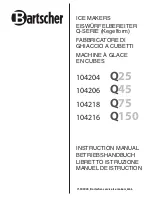
Copies of the I/B. Please reproduce them without any
changes except under special instruction from Team
International BELGIUM. The pages must be reproduced
and folded in order to obtain a booklet A5 (+/- 148.5 mm
width x 210 mm height). When folding, make sure you
keep the good numbering when you turn the pages of
the I/B. Don’t change the page numbering. Keep the
language integrity.
Fax +32 2 359 95 50
Sugar
Sugar is important for the colour and flavour of breads. It is also food for yeast as it supports the
fermentation process. Recipes that call for sugar require granulated sugar. Do not substitute
granulated sugar by powdered sugar or brown sugar unless indicated. Artificial sweeteners
cannot be used as a substitute for sugar as yeast will not react properly with them.
Salt
Salt is necessary to balance the flavour of breads and cakes, as well as for the crust colour that
develops during baking. For dietary reasons, it may even be eliminated entirely, however, your
bread may over-proof and rise higher than normal.
Liquids/milk
Liquid such as milk or a combination of powdered milk and water can be used when making
bread. Milk will improve flavour, provide a velvety texture and soften the crust, while water
alone will produce a crispier crust. Use only powdered milk when using the delay timer. Some
recipes call for juice (orange, apple, etc.) to be added as a flavour enhancer.
Eggs
Eggs add richness and velvety texture to bread dough and cakes. Use only large-size eggs in
these recipes.
Butter, oil and margarine
Butter, oil and margarine shorten or tenderise the texture of yeast breads. However, breads
that call for butter stay fresh longer. If butter or margarine is used directly from the refrigerator,
it should be cut into small pieces for easier blending during the kneading cycle.
Baking powder
Baking powder is a leavening agent used in quick breads and cakes. This type of leavening
agent does not require rising time before baking as the chemical reaction works during baking
process.
Baking soda
Baking soda is another leavening agent not to be confused with nor substituted for baking
powder. It also does not require rising time before baking as the chemical reaction works
during baking process.
Special glazes for yeast breads
Select one of the following glazes to enhance your bread:
Egg glaze:
Beat 1 large egg and 1 tsp of water together, brush generously. Apply to dough
only, before baking in your regular oven.
Melted butter crust:
Brush melted butter over just-baked bread for a softer, tender crust.
Milk glaze:
For a softer, shiny crust, brush just-baked bread with milk or cream.
28
VG BBA 1 - 110711
Assembly page 28/168
















































